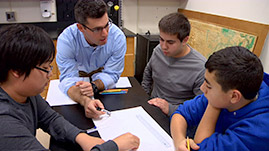Teachers' Domain - Digital Media for the Classroom and Professional Development
User: Preview



Executive Producer Jill Peters
Producer Michelle Chen
Associate Producer Eliana Cruz
Content Producer Sybil Berry
Camera Greg Barna, Michael Pruitt-Bruun
Audio Ken Chin
Editor Michiel Pilgram
Re-recording Mixer Jon Berman
Music Supervision Rosie Fishel
Senior Budget Controller Rekha Menon
Intern Megan Schumm
Special Thanks to Herricks High School, Ward's
Director of Children's and Educational Media Sandra Sheppard

In this video, Andrew Cloud uses his students as physical representations of the earth and moon. Please note that some teachers prefer to use spheres to model this concept.
Use the Lunar Eclipse Essentials video as a reinforcement to the in-class demonstration of lunar and solar eclipses. To place the video in context to the lesson, follow the tips for using video below.
Ask students to look for the position of the penumbra and umbra and to answer the following question:
What is the sequence of the earth, moon and sun for a lunar and solar eclipse to occur?
After watching the video, take student responses to the question. As an assessment, ask students to explain how an eclipse occurs.
Eclipse ActivitiesBreak class up into groups. Provide each group with colored pencils and white paper. Tell students that each group is responsible for drawing two diagrams, one of a lunar eclipse and one of a solar eclipse. Remind students that they must include the correct positions of the Earth, Moon, and Sun and the proper size and orientation of shadows.
After students complete the drawings ask them to create a series of questions that relate to the drawings and the Lunar Eclipse Essentials video.
As a culminating activity, each group chooses one question to pose to the rest of the class as part of a guided class discussion. Have students hand in the illustrations and questions at the end of the period for a homework grade.
Using VideoWhen showing a video always provide a Frame, a Focus and a Follow-up:
FrameProvide a context that helps students pay attention to the main content of the video. Ask students questions about the topic explored in the video to activate prior knowledge.
FocusHelp students notice the important moments in the video by providing them with a specific focus, something to look for while they watch.
Follow-upProvide an opportunity for students to summarize and discuss what they saw. Re-telling what they saw helps students consolidate their understanding and remember it.
Play the video multiple times to enhance understanding. Depending on your classroom set-up or the availability of computers or tablets, play the video for the entire class or encourage students to watch independently or in small groups. Pause the video at particular moments to review content or let students take notes. Let students know it is okay to play the video as many times as necessary to gain a full understanding of the content.
 Loading Standards
Loading Standards